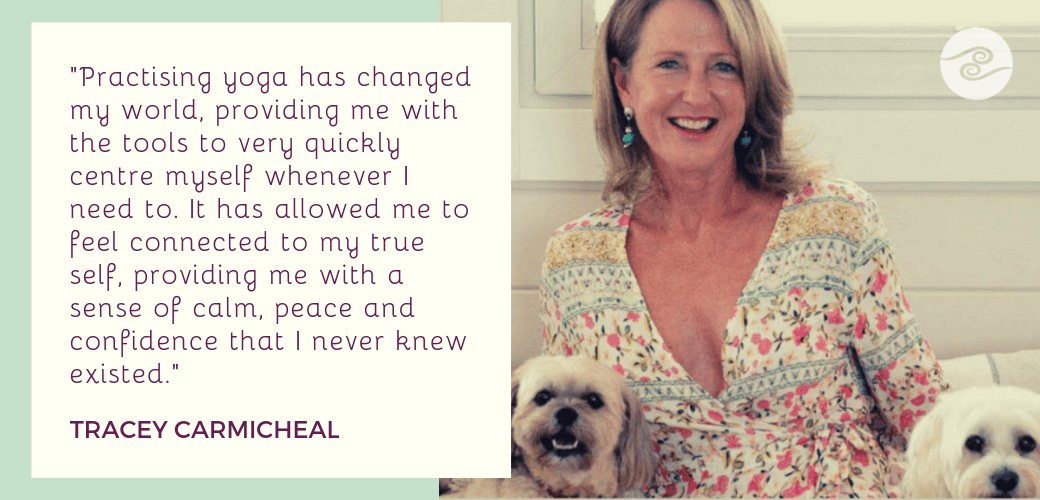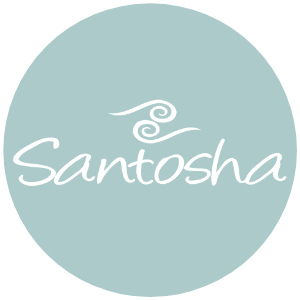
Yoga and the Happy Mind
One of the best things about our Yoga Teacher Trainings…
are the wide range of fascinating people who join us on the yoga training journey. We meet all sorts of professionals who are doing the Santosha Yoga Teacher Training to enhance and build on their existing careers. It is truly inspiring to hear how people plan on using yoga alongside the work they already do.
One such person is Tracey Carmicheal, who is an Author, Life Coach, NLP and Time Line Therapy Practitioner. Tracey had profound results incorporating yoga into her own life and wanted to share the benefits of yoga with her clients. So she joined us on the Santosha Yoga Teacher Training, and has now added yoga to her impressive lists of skills and services!
Tracey has just launched her new business – the Happy Mind Studio – and is already offering boutique and private yoga classes.
We are so proud and happy for this amazing lady for following her dreams and assisting others live their lives to the fullest everyday. What could be a more rewarding career?
Tracey took some time out from her busy schedule to share her experiences with using yoga to deal with depression and anxiety, and to explain how she finds yoga helps others who are going through the same conditions.
Yoga is the oldest system of personal development in the world, encompassing body, mind and spirit.
The practise of yoga can help to free you from life’s sorrows and from the diseases and fluctuations of the mind.
It is about coming back to yourself, finding your limits, expanding your boundaries and learning to truly relax in your body and mind.
Yoga gives you the ability to move from living in a body that is wound up, twisted and bound tight to living in a body that is open, flexible and free. This has a direct effect on the consciousness, allowing you to move from stress to de-stress, depression to lightness and anxiousness to calm.
I began my yoga journey 7 years ago and without it sounding too cliché, it changed my life. I had spent most of life in a state of anxiety and the only way I knew to relieve the anxiety was to “flog” myself with hard core exercise. I pumped iron, ran, cycled, paddled a surf ski, surfed and ocean swam. Without hard core exercise my “monkey mind “would take over. I pushed myself so hard that I ended up in Adrenal failure and a state of depression.
I was at a point in my life where something had to change; I bit the bullet and booked a series of private yoga sessions. At my core I had always known that I needed to start a yoga practice but I was too scared to let go of what I was doing just in case the yoga was not enough to keep the anxiety at bay. Oh my, how wrong was I. After the first session I was hooked. I found a peace and calm I have never experienced before.
I had two sessions a week with my instructor and homework to do each day and from that day forward it is rare that I have missed a day without a yoga practice.
After 15 years in the wellness industry as a remedial massage therapist and weight loss consultant I now work as a mindset and wellness coach implementing my teachings of the Happy Mind Formula to people in a state of anxiety and depression and yoga and meditation are a big part of theses teachings.
I went to Bali in March and completed the Santosha Yoga Teacher Training so that I could incorporate and teach yoga within my coaching practice, rather than referring clients on.
The course was amazing and perfect for what I wanted to share with my clients. The focus was on breath leading the movement and moving dynamically and safely within poses; a beautiful practice to enhance and encompass what I already teach.
I believe that Yoga is a path of natural recovery and healing from anxiety and depression. By opening the body with yoga postures and breath, we increase the energy flow and life force that is critical for healing and unlocking trapped emotions. Yoga stimulates the glands, organs and brain with freshly oxygenated blood, bringing the chemicals of the body back into balance naturally without using drugs.
In 1987, the introduction of Prozac helped millions of people all over the world find relief from the crippling symptoms of depression. This type of drug helps to balance the brain chemistry by using serotonin reuptake inhibitors; however, they also come with many side effects including nausea, sexual dysfunction, weight gain, insomnia and lethargy.
Yoga has been shown to produce similar results as antidepressants without any side effects.
Certain yoga postures stimulate the endocrine system to produce serotonin, while other postures normalise over-functioning of the hormones and help to maintain balance in the endocrine system.
Yoga is meditation in motion. The physical part of yoga (asana), stretching, lengthening and holding in postures, requires focus and can be quite strenuous, allowing you to have a full awareness of your body. It is this awareness that draws the mind back to the present moment.
Research has proven that by living more in the present moment we can be free of negative mind states, manage stress better, improve relationships and have happier and more stable lives.
The breath is what joins the mind and body and is an essential ingredient to connecting the conscious mind to the unconscious mind.
The human body exists only in the present moment, unlike the mind, which tends to drift off into the past and future. Drifting into the past can drag up memories and give a feeling of longing or emptiness. Drifting into the future can create anxiety for the things we do not have or tasks or projects we need to get done. The power is in the now; the past and the future hold no power.
The various yoga postures exercise every part of the body, toning and firming muscles and working on ligaments, tendons, joints, internal organs, glands and the nervous system.
The digestive system is ignited, helping the body to metabolise food more efficiently, controlling appetite and weight. Bowel movements are more regular as the colon is massaged and the endocrine system becomes more stable as the hormonal glands are activated. In every yoga posture and breath, every cell in the body is nourished, cleansed and revitalised.
In order to get the most out of your yoga practice, the breath is the key.
When we are anxious or depressed our breathing can often become very shallow, reducing oxygen supply to the brain, muscles and organs. Shallow breathing leads the body and the mind to feel sluggish, dull and tense.
Deeper breathing is calming, soothing and healing and provides a feeling of cleansing, clarity and lightness.
When you learn to focus on the breath while you are in the postures, your body will begin to release and with regular practice you will notice a change in your mental attitude and approach to life.
Yoga is not difficult; if you can breathe, you can do some form of yoga. Lack of flexibility is what holds some people back from giving it a try; however, it is lack of flexibility which is the precise reason to start. When the body is stiff and inflexible it can hold many negative emotions. Yoga is the key to unlocking your body, releasing these emotions and bringing a sense of ease.
The effects of a yoga session can be almost instantaneous and on a long term basis can be profound in helping you to find balance, both mentally and physically.
Practising yoga has changed my world, providing me with the tools to very quickly centre myself whenever I need to. It has allowed me to feel connected to my true self, providing me with a sense of calm, peace and confidence that I never knew existed.
~~~~~~~~~~~~~~~~
Thank you so much Tracey for sharing your story – and your incredible wisdom – with us! To begin your own journey on our Santosha Yoga Teacher Training please visit our Level 1 course information page here.
For more Tracey, including coaching and online packages please visit Happy Mind Studio here.
View a video message from Tracey here.


Sorry, the comment form is closed at this time.